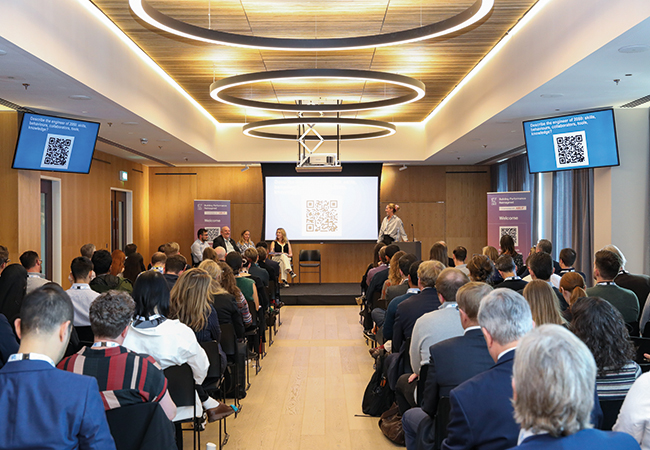
A new CIBSE conference, in central London, has challenged building professionals to adopt a more holistic approach to design and come up with new perspectives on building performance.
Building Performance Reimagined, held at the Royal College of Surgeons, brought together developers, architects, planners, surveyors, researchers, facilities managers, and contractors. It was centred on the Building Performance Reimagined report commissioned by CIBSE, and panel discussions covered the four critical performance metrics in the document: variety, readiness, connectedness, and emergence.
In her keynote, CIBSE President Fiona Cousins emphasised the need to question whether we are solving the right problems. She said that buildings of tomorrow must respond to new needs, some of which we may not yet be fully understand.
In the first session, on readiness and emergence, consulting trainer and facilitator Wolfgang Wopperer-Beholz highlighted the imperative to reconsider human needs in light of climate change and inequality. ‘There will be instances when we will need to go back to basics – buildings as shelter, creating social and physical resilience,’ he said. Dr Emma McIntyre, senior fire safety engineer at Arup, said there had to be a shift towards more people-centric design, and to understanding emerging risks, to ensure spaces can continue to be safe havens. She highlighted the need for flexibility within standards and regulations, and said it was crucial to understand the intent behind regulations. CIBSE’s chief technical officer, Anastasia Mylona, noted that the industry’s requirement for complete certainty before making changes often stifles innovation.
In a discussion on skills, the Department for Energy Security and Net Zero’s Dr André Neto-Bradley advocated for people from a wide range of backgrounds. ‘We need more than engineers and architects; we need to bring in art students and social scientists to broaden perspectives.’ Dave Richards, director of technical infrastructure at Google, suggested that everyone involved in design should experience building operations to better understand performance.
In session two, on variety and connectedness, the panel discussed the importance of design, data and technology in creating resilient, energy-efficient buildings for the future. ‘Variety means having spaces that are flexible today and adaptable to future needs,’ said Richards, adding that data must drive design decisions.
Mission steward at Dark Matter Labs Indy Johar stressed the importance of engineering for multiple options for an uncertain future, where temperatures may range from -20°C to 40°C in the UK, for example.
UCL doctoral researcher Emma Gibbons called for better knowledge of human and ecological systems. ‘The “mother of all feedback loops” is coming back to kick us,’ she warned, advocating for the reuse of materials.
Future skill requirements was the topic of the third session. Jo Harris, hard FM ambassador at Sodexo, said young people often learn more from videos than lectures or books. The panel agreed there needed to be a move away from linear, static guidance and towards multifaceted guidance that cultivates human and soft skills. However, Ted Pilbeam, building services and sustainability director at VolkerFitzpatrick, said sound engineering knowledge was still crucial to ensure designers ask the right questions.
The fourth session brought together young engineers and the panel discussed the role of technology, specifically artificial intelligence (AI), in engineering and design. They emphasised moving beyond short-term, box-ticking regulations to a broader, more sustainable view of design, with Cundall senior engineer Lauren Davies suggesting nature should be considered a stakeholder when designing spaces.
